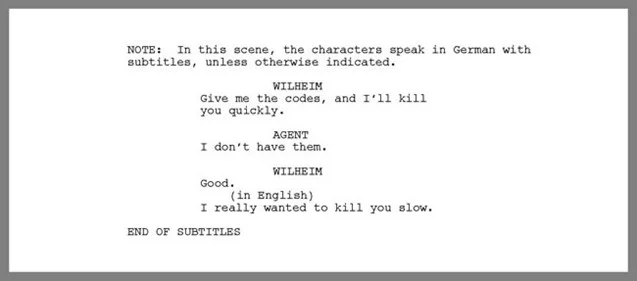
Dialogue: Foreign Languages
by T. J. Alex
Book Excerpt, 3 pages
Viewed by: 27 Residents and 4400 Guests

Dialogue: Foreign Languages
How a writer formats Foreign Languages largely depends on how much information the writer wants to divulge to the audience, given they don't speak the language.
No Subtitles :
In my opinion, the best screen writers are those that can create a full scene in a foreign language without a single subtitle, but construct it in a way so that the audience gets the gist of what was said.
Here is a small and simple example of a piece of dialogue written in a Foreign Language:

Even if the reader doesn't speak the language, through the context of the scene, the reader can likely deduce what was said.
Sometimes a character need not speak completely in the Foreign Language, but bits of his native tongue can be sprinkled in here and there to give the scene some foreign flare.
Take this bit of Dialogue, for example:

Donna fine means "fine lady" in Spanish (or so I'm told). To emphasize the foreign words, the writer could also underline them (NEVER italicize within Dialogue).
But what if the writer doesn't speak ANY of the language he wants a character to speak?
Well, then use a Parenthetical to indicate the language in which the Dialogue will be spoken.
Look at this example:

Using Subtitles :
Well, that's good and all, but it would be hard to tell the audience what Wilheim said simply through the scene's context. If the writer wants the audience to be privy to Wilheim every word, he'll need to indicate it through the use of Parentheticals.
As a matter of fact, the very same Parenthetical, like this:

Of course, if this is just a part of a longer scene in which characters converse in German, seeing (in German; subtitled) after each and every Character Heading is going to get old for the reader.
A better option would be to indicate the fact characters will be speaking German throughout the scene in a Special Notation or a Direction paragraph.
Here's one way to handle it:

I indicated the end of the subtitles with the Subheader END OF SUBTITLES.
But what if the characters MOSTLY speak German, but occasionally one of them will glide into English?
Notice the subtle changes to the same scene:

Finally, let's say a writer basically makes up his own language for a character to speak. Maybe the character is of an alien species, or a member of a long, lost human tribe whose language is unknown.
In cases like this, the writer may write the words as he or she envisions the actor pronouncing them, and then use a separate Character Heading for the subtitles, pulling the two separate Dialogue blocks together through the use of Dual Dialogue.
Look at this example:

----------------------
For more screenplay formatting rules and advice, check out the book, Your CUT TO: Is Showing! by T. J. Alex or visit www.scripttoolbox.com.
From there, please like the page on Facebook, and share it with your friends. If you have any formatting questions, please email T. J. at tj@tjalex.com.




